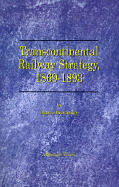|
|
|
|
||||||

|
Transcontinental Railway Strategy, 1869-1893: A Study of Businessmen
By Julius Grodinsky 2000/10 - Beard Books - Business Classic 1587980037 - Paperback - Reprint - 464 pp. US$34.95 A fascinating history of the successes and failures of the pioneering stage of the Western railway system in the United States. Publisher Comments
This
fascinating history chronicles the building of the Western railway
system in the United States and of the trailblazers who made it a
reality. Through painstaking and creative research, including
contemporary news accounts, company financial records, Congressional
records, personal papers, and biographies of the main players, it
reviews the boom times and the bust times of the greatest growth of
railways the world has ever seen.
Review by Gail Owens Hoelscher Railroads were pioneers of the American frontier. Union Pacific; Central Pacific; Kansas and Pacific; Chicago, Rock Island and Pacific; Chicago, Burlington and Quincy; Atchison, Topeka and Santa Fe: these names evoke boom times in America, the excitement and tumult of seemingly limitless growth and opportunity, frontiers to tame, fortunes to be made. Railroads opened up vast supplies of raw materials, agricultural products, metals, and lumber. The public gain was incalculable: job creation, low-cost transportation, acceleration of westward immigration, and settlement of the frontier. The building of the western railway system in the United States was described at the time as "one of the greatest industrial feats in the world's history." This book tells the story of the trailblazers of the Western railway industry, men with a stalwart willingness to take on extraordinary personal financial risk. As a group, these initial railroad promoters were smart, bold, tenacious, innovative, and fiercely competitive. Some were cautious with their and their investors' money, some reckless. Most met with financial setbacks, some with total failure, some time and time again. They often sold out at great losses, leaving their successors to derive the benefits later. Bitter competition existed among these men. They fought to position their "roads" in a limited number of mountain passes, rivers, and valleys; and to chart routes which connected major production areas with major consumption areas. They cajoled and begged almost anyone for capital. They created and tried to defend monopolies. They bullied each other, invaded each other's territories, and retaliated against each other. They staged wage wars. They agreed not to compete with each other, and bought each other out. The book opens in May of 1869, just after the completion of the first transcontinental route joining the Union Pacific Railroad and the Central Pacific Railroad in Ogden, Utah. The companies' long-term prospects were excellent, but right then they were desperate for cash. Union Pacific alone was more than $15 million in debt. Additional financing was proving scarce. By 1870, more than 40 railroads were floating bonds, "at almost any price for ready cash," wrote one contemporary observer. Still, funds were raised and construction went on, both of transcontinental lines and branch lines. As railway lines in the West were built in relatively unsettled areas, traffic was light and returns correspondingly low. To increase business, the companies found ways to encourage population growth along their routes. Much-needed funding came from immigration services set up by the railways themselves. Agricultural areas sprang up along the routes. Sometimes volume of traffic expanded too fast, and equipment shortages and construction delays occurred. Or, drought, recession, and low agricultural prices meant more red ink. This book takes the reader through the boom times and bust times of the greatest growth of railways the world has ever seen. The author uses a myriad of sources showing painstaking and creative research, including contemporary news accounts; railway company financial records and archives; contemporary industry journals; Congressional records; and personal papers, letters, memoirs and biographies of the main players. It's a good, solid read. Julius Grodinsky was a professor at the Wharton School of Business and a foremost railroad historian.
|
|
|
|
home
| about us
| contact us
| related
sites |